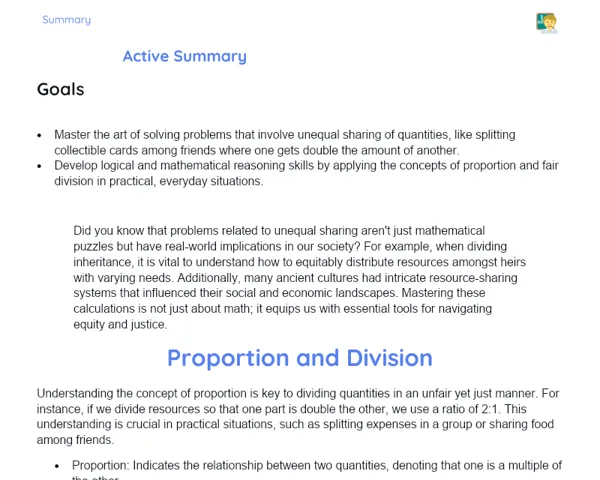Summary Tradisional | Factorization: Grouping and Evidencing
Contextualization
Factoring is a crucial technique in algebra that helps simplify algebraic expressions and solve complex equations more effectively. Essentially, when we factor an expression, we are 'breaking it down' into smaller, manageable parts, similar to finding the prime factors of a number, where we decompose it into its simplest prime components. By identifying and grouping common factors within the terms of an expression, we make simplification and the process of solving equations much easier.
Different methods of factoring exist, including factoring by grouping and factoring by common factors. Factoring by grouping involves collecting similar terms of the algebraic expression, whereas factoring by common factors requires us to find a common factor present in all the terms and bring it out. Both methods are vital skills that students can master for simplifying expressions and tackling mathematical problems, not only in algebra but also in numerous real-world applications.
To Remember!
Introduction to Factoring by Grouping
Factoring by grouping is a technique used to simplify algebraic expressions through the grouping of similar terms and factoring each group. This method involves identifying terms with common factors and grouping them in a way that makes factoring straightforward. For example, in an expression like ax + ay + bx + by, we can group the terms as (ax + ay) and (bx + by), allowing us to factor each group effectively: a(x + y) and b(x + y), leading to the rewritten expression (a + b)(x + y).
This approach is particularly helpful when the terms within an expression lack an apparent common factor across the whole expression but can be grouped to reveal common factors in smaller subsets. This process aids in the simplification of the expression and facilitates the solution of polynomial equations.
To successfully apply factoring by grouping, students need to practice identifying patterns and common factors, as well as rewriting terms to facilitate grouping. This method is a powerful asset for simplifying complex algebraic expressions and is frequently used in more advanced mathematical problems.
-
Grouping similar terms to facilitate factoring.
-
Factoring each group based on commonality.
-
Rewriting the expression in a simpler form.
Practical Example of Grouping
An excellent example of factoring by grouping is the expression ax + ay + bx + by. First, we identify the similar terms and group them: (ax + ay) and (bx + by). Next, we factor each group: a(x + y) and b(x + y). Lastly, we rewrite the expression as (a + b)(x + y), clearly demonstrating the simplification achieved through this method.
This example showcases how factoring by grouping can convert a complex algebraic expression into a simpler and more manageable form. Recognizing the correct terms to group is key to the success of this method. Regular practice with various expressions helps students sharpen their skills in identifying patterns and effectively applying factoring.
By working through practical examples, students can understand how factoring by grouping is relevant to real-life situations, making the learning experience more impactful. Guided practice with similar problems reinforces their comprehension and ability to factor algebraic expressions.
-
Identification and grouping of similar terms.
-
Factoring each group of terms.
-
Simplification of the resulting expression.
Introduction to Factoring by Common Factors
Factoring by common factors is a method utilized when there is a common factor present in all terms of an algebraic expression. This involves identifying that common factor and bringing it out, thereby simplifying the expression. For instance, in the expression 3x + 3y, the common factor is 3. By factoring out 3, we can rewrite the expression as 3(x + y).
This method is particularly beneficial when an expression has terms that exhibit an obvious common factor. Identifying this factor enables us to simplify the expression for easier manipulation and solving of equations.
To effectively use factoring by common factors, students must practice recognizing common factors and rewriting terms accordingly to bring out that factor. This technique is indispensable for simplifying algebraic expressions and is commonly applied in various mathematical problems and practical scenarios.
-
Identifying a common factor in all terms.
-
Bringing out the common factor.
-
Simplification of the resulting expression.
Practical Example of Common Factors
A straightforward example of factoring by common factors is the expression 6a^2 + 9a. Here, we identify the common factor, which is 3a. Factoring out 3a simplifies the expression to 3a(2a + 3). This example illustrates how finding a common factor can simplify a complex algebraic expression.
Factoring by common factors is frequently utilized in mathematical problems for expression simplification and equation solving. Engaging in practical examples allows students to develop their skills in recognizing common factors and applying factoring effectively.
By working through various examples, students can observe how factoring by common factors applies in real-world situations, making the learning process more relatable. Guided practice with similar examples enhances their competencies and understanding of how to factor algebraic expressions.
-
Identifying the common factor in all terms.
-
Bringing out the common factor.
-
Simplification of the resulting expression.
Key Terms
-
Factoring: The process of decomposing an algebraic expression into smaller components.
-
Grouping: A factoring technique that involves collecting similar terms to facilitate the simplification.
-
Common Factors: A method focused on identifying a common factor in all terms of an expression and factoring it out.
-
Algebraic Expressions: Combinations of numbers, variables, and operators representing mathematical quantities.
-
Similar Terms: Terms within an algebraic expression with the same variables raised to the same powers.
Important Conclusions
This lesson covered the methods of factoring by grouping and by common factors, both essential techniques for simplifying algebraic expressions and solving complex equations. Factoring by grouping emphasizes collecting similar terms, while factoring by common factors revolves around identifying and pulling out a common factor. Both methods serve as powerful tools for addressing mathematical problems and simplifying expressions.
The significance of these techniques extends beyond the classroom. They have real-world applications in fields such as cryptography and engineering, highlighting the practical importance of the subject. Mastering these techniques equips students with a strong foundation for future mathematical topics like solving quadratic equations and simplifying algebraic fractions.
Consistent practice in applying factoring methods across different contexts is vital for reinforcing knowledge. Encouraging students to delve deeper into the topic and tackle additional problems can further enhance their understanding and proficiency in algebra, preparing them for advanced mathematical challenges.
Study Tips
-
Review the examples from class and practice solving similar problems to strengthen your recognition of patterns and application of factoring methods.
-
Utilize additional resources like math textbooks and online platforms to discover more exercises related to factoring by grouping and common factors, and solve them to solidify your learning.
-
Form study groups with classmates to share doubts and insights regarding factoring methods. Explaining the concepts to peers can significantly reinforce your understanding.



